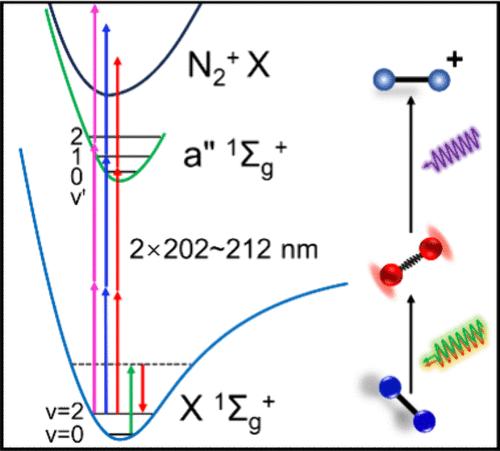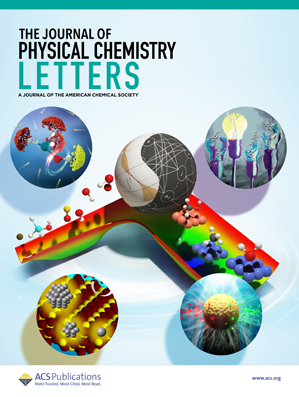通过受激拉曼泵浦实现氮分子的泛音激发
IF 4.8
2区 化学
Q2 CHEMISTRY, PHYSICAL
引用次数: 0
摘要
氮键活化是化学中的一个关键过程,键激发是理解其基本机制的基础,因此制备特定量子态的分子至关重要。在此,我们首次报道了在脉冲分子束中利用受激拉曼泵浦(SRP)方法将 N2 分子从 X1Σg+(v = 0, j = 0, 1, and 2) 泛函激发到 X1Σg+(v = 2, j = 0, 1, 2, and 3)。通过 a″1Σg+ 状态,利用 2+1 共振增强多光子电离检测 N2。在 SRP 激光强度饱和的激发区域内,激发效率达到了 4%,这表明该过程的横截面很小。测量了不同分支的 SRP 失谐光谱,并进一步利用激发的 N2 [X1Σg+(v = 2)]进入 a″1Σg+ 的各种振动状态,从而确定了其振动常数。这项研究为研究氮在反应和散射实验中的特定高振动激发开辟了新的机会,并为 N2 分子提供了更多精确的光谱数据。本文章由计算机程序翻译,如有差异,请以英文原文为准。

Overtone Excitation of Nitrogen Molecules via Stimulated Raman Pumping
Nitrogen bond activation is a pivotal process in chemistry, with bond excitation being fundamental to understanding the underlying mechanisms, making the preparation of molecules in specific quantum states crucial. Here we report the first overtone excitation of the N2 molecule from X1Σg+(v = 0, j = 0, 1, and 2) to X1Σg+(v = 2, j = 0, 1, 2, and 3) using the stimulated Raman pumping (SRP) method in a pulsed molecular beam. N2 was detected using 2+1 resonance-enhanced multiphoton ionization through the a″1Σg+ state. An excitation efficiency of 4% was achieved within the excitation region in which the SRP laser intensity was saturated, indicating the low cross-sectional nature of the process. The SRP detuning spectra for different branches were measured, and the excited N2 [X1Σg+(v = 2)] was further used to access various vibrational states of a″1Σg+, enabling the determination of its vibrational constants. This research opens up new opportunities for studying the specific high vibrational excitation of nitrogen in reactions and scattering experiments and contributes additional precise spectral data for the N2 molecule.
求助全文
通过发布文献求助,成功后即可免费获取论文全文。
去求助
来源期刊

The Journal of Physical Chemistry Letters
CHEMISTRY, PHYSICAL-NANOSCIENCE & NANOTECHNOLOGY
CiteScore
9.60
自引率
7.00%
发文量
1519
审稿时长
1.6 months
期刊介绍:
The Journal of Physical Chemistry (JPC) Letters is devoted to reporting new and original experimental and theoretical basic research of interest to physical chemists, biophysical chemists, chemical physicists, physicists, material scientists, and engineers. An important criterion for acceptance is that the paper reports a significant scientific advance and/or physical insight such that rapid publication is essential. Two issues of JPC Letters are published each month.
 求助内容:
求助内容: 应助结果提醒方式:
应助结果提醒方式:


